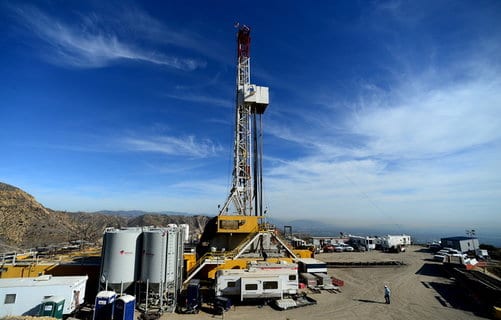
This October, a large leak was discovered at the Aliso Canyon natural gas storage facility in northwest Los Angeles. The leak is a serious health risk to nearby residents, and because methane – the primary component of natural gas – is a potent greenhouse gas, some have called this leak a “disaster” for climate change.
To be sure, this leak, which is projected to continue for several weeks, is very significant. But because natural gas leaks every day from thousands of locations across the United States, Aliso Canyon’s emissions are actually quite small when measured on a national scale – less than one percent of natural gas’ contribution to national emissions.
Given its relatively modest greenhouse gas impact, research on energy and climate policy tells us that this leak is not by itself a “climate disaster.” Instead, it is more productive to think of Aliso Canyon as an opportunity: while fixing the leak must be a high priority for local, state and federal officials, it should also provide the impetus to tackle the dispersed sources of methane from the oil and natural gas industry that contribute far more to climate change than any single well ever could.
Natural gas and methane in the U.S.
Natural gas production and consumption have grown substantially in the United States over the past 10 years, and debate has raged over a variety of issues related to producing gas from shale using hydraulic fracturing, or fracking.
Because it has displaced a substantial amount of coal for electricity generation, natural gas has helped reduce U.S. CO2 emissions from our power plants by 18 percent since their peak in 2005.
Carbon dioxide (CO2) is the most important greenhouse gas, but methane comes in second. The U.S. Environmental Protection Agency estimates that methane contributed roughly 10 percent of domestic greenhouse gas emissions in 2013, and that the largest source was the oil and natural gas sector. These emissions occur when natural gas is either (unintentionally) leaked or (intentionally) vented from well sites, compressor stations, pipelines and other facilities.
In recent years, EPA’s estimates of methane emissions from the natural gas system have come under question, generating debate over whether natural gas helps or hurts in the fight against climate change.
The most comprehensive research, supported by the environmental advocacy group Environmental Defense Fund, suggests that methane emissions from natural gas systems may be roughly 50 percent higher than EPA’s estimates, though substantial uncertainty remains.
Aliso Canyon’s overall climate effect
As shown in startling infared videos, Aliso Canyon’s faulty well is leaking methane at an astonishing rate.
If the well is plugged by March 31 (reported estimates range from late February to late March), Aliso Canyon will likely have leaked methane equivalent to roughly four million metric tons of CO2, about one third more than all of what Washington, D.C. emitted in 2013.
These calculations are based on estimates from the California Air Resources Board, assuming a steady leak rate from January 8 through March 31. It uses a 100-year global warming potential (GWP) – a method to compare other greenhouse gases to carbon dioxide – of 32.
While this leak is indeed substantial, perhaps the more startling fact is that it is small compared with methane emissions from other oil- and gas-related sources.

The EPA estimates that annual methane emissions from the domestic natural gas system were roughly 130 million metric tons of CO2 equivalent (MMTCO2-e) in 2012. If they are underestimating this number by 50 percent, we get roughly 195 MMTCO2-e of methane. Using this estimate, we can say that Aliso Canyon will increase the methane footprint of the U.S. natural gas system by about 2 percent over 12 months.
When we account for the entire natural gas system, including methane and CO2 emissions (this includes all emissions from producing, transporting and burning natural gas), Aliso Canyon would add about 0.3 percent to the 12-month total.
A bigger problem
So does Aliso Canyon matter?
Absolutely. First, the leak has forced families in the Porter Ranch neighborhood of Los Angeles to temporarily relocate, disrupting thousands of lives.
Second, the leak has a real, if modest, effect on climate change. As demonstrated above, any single emissions source measured against the herculean scale of the energy system will look small, but Aliso Canyon reminds us that aging facilities that produce, transport and store natural gas need to be closely monitored.
An infrared camera shows the leak of methane stored in an underground cavern in northwest Los Angeles.
But perhaps most importantly, Aliso Canyon should be a signal to businesses and policymakers: methane emissions across the natural gas (and oil) supply chain need to be addressed.
One recent study estimated that most leaks can be fixed at extremely low cost, and others have found that a large portion of emissions come from a small number of “super-emitters,” unmonitored facilities that belch methane into the air.
This research suggests that well-designed state or federal regulations targeting methane emissions can get a lot of bang for the buck. The EPA has for years operated a voluntary program to encourage companies to reduce their emissions, and recently proposed rules to reduce methane emissions at new natural gas facilities. In addition, some states are now requiring oil and gas producers to limit their methane emissions.
But these initiatives represent exceptions rather than the rule. Methane emissions from oil and gas systems are poorly understood, and in most cases unmonitored and unregulated by governmental agencies.
As the United States and the world move forward to tackle the challenge of climate change, Aliso Canyon should focus minds and encourage businesses and policymakers to address the broader issue: it’s time to reduce methane emissions across our oil and natural gas systems.
Source: The Conversation. Reproduced with permission.







